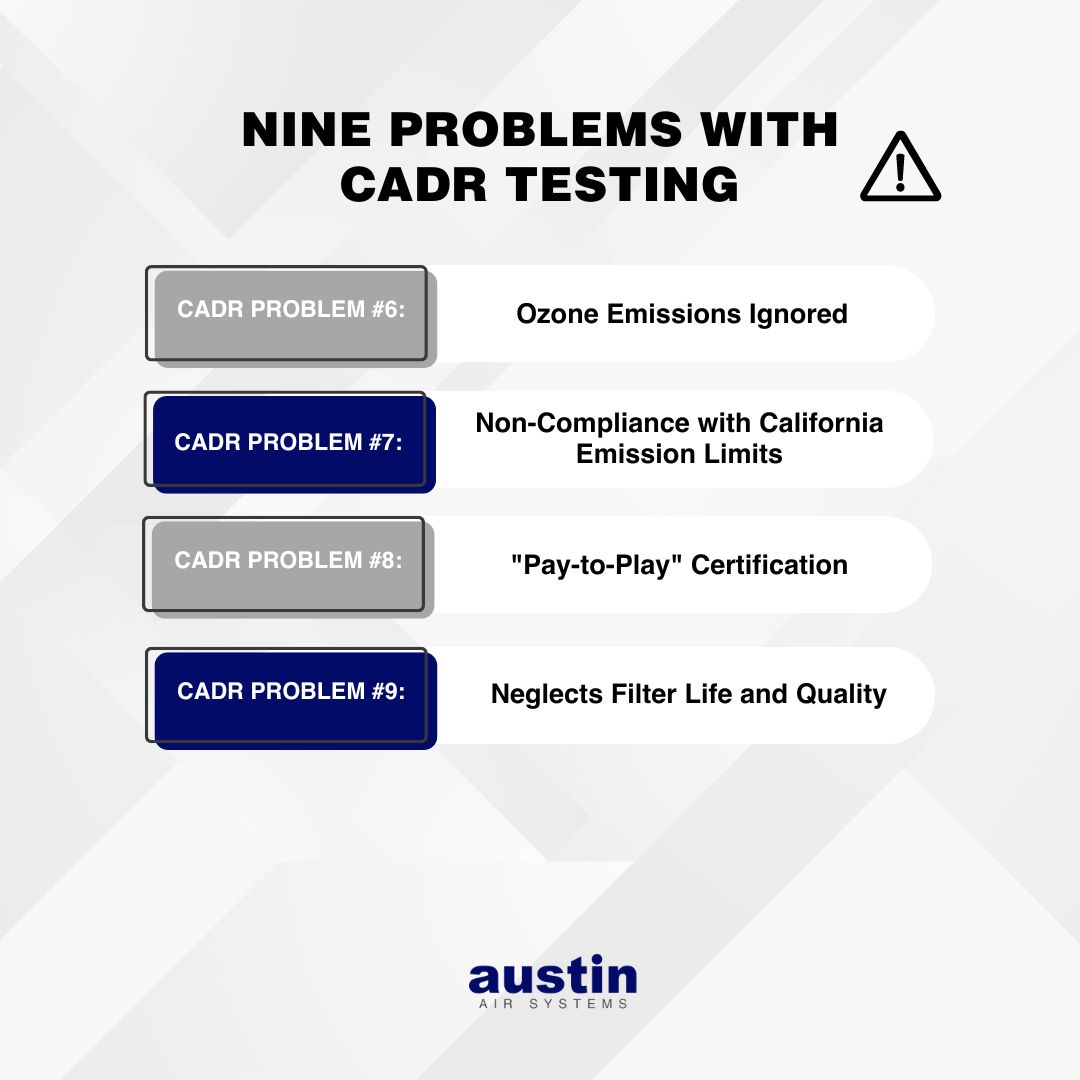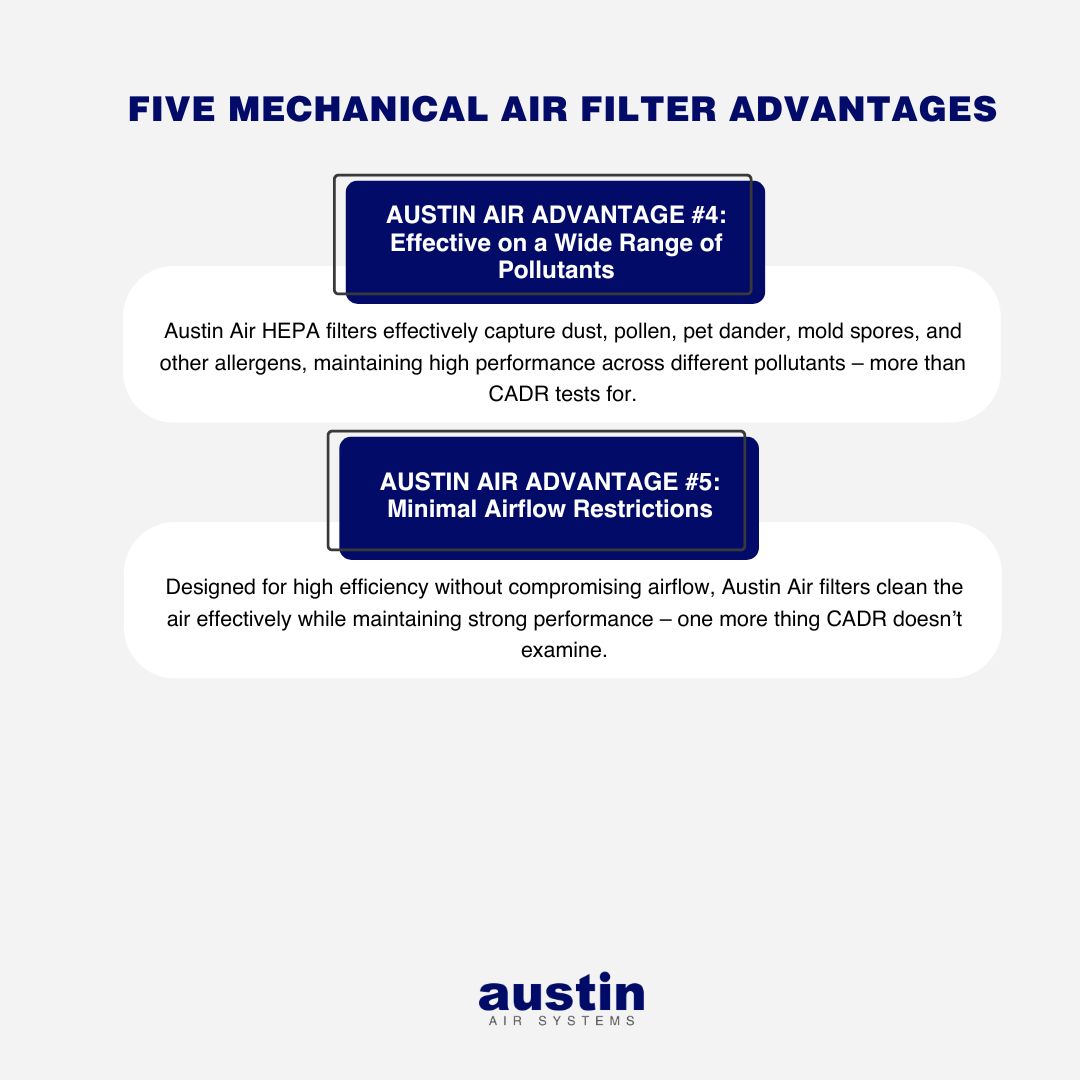According to some, the most helpful parameter for understanding the effectiveness of portable air cleaners is the clean air delivery rate (CADR), which is a measure of a portable air cleaner’s delivery of relatively clean air, expressed in cubic feet per minute (cfm).
The CADR is determined by multiplying the air cleaner’s airflow rate by its efficiency in removing a specific pollutant. In general, a higher CADR relative to the size of the room should (theoretically) increase the effectiveness of a portable air cleaner.
However, the truth is that folks need to start looking beyond the old rating system and more closely at air filtration technology because the CADR has many shortcomings.
CADR PROBLEM 1: Unrealistic Testing Conditions
First and foremost, CADR is determined in laboratory settings with controlled conditions, which don’t accurately reflect real-world performance in homes or workplaces. For instance, it doesn’t account for continuous pollutant sources like cooking, smoking, or outdoor pollution.
CADR PROBLEM 2: Limited to Small Group of Pollutants
Current test standards only rate CADRs for the removal of some particles. CADR ratings are based on the removal of particles such as tobacco smoke, dust, and pollen, but they do not account for other common pollutants like volatile organic compounds (VOCs), bacteria, or viruses.
CADR PROBLEM 3. Variability in Particle Size
CADR ratings are based on the removal of particles of a certain size range, but air purifiers may not be equally effective at removing particles of different sizes.
CADR PROBLEM 4: Room Size and Placement Assumptions
CADR assumes optimal placement and a specific room size, which may not match actual usage conditions. In reality, room layout, furniture, and placement can significantly affect performance.
CADR PROBLEM 5: Short Testing Period
CADR ratings are based on short-term testing, with tests only lasting 15-20 minutes. This short time frame doesn’t reflect the long-term performance of the air cleaner. A device might perform well initially but lose effectiveness over time. Another fact is that the lack of long-term performance data goes against scientific best practices.
CADR PROBLEM 6: It Does Not Consider Ozone Emissions
Some air cleaners use technologies like ionization, ozone generation, or ultraviolet germicidal irradiation (UVGI), which emit harmful byproducts including ozone. CADR does not account for the potential health risks from these emissions. It’s baffling that a product meant to clean the air could cause indoor air pollution and even more absurd that a test for clean air delivery doesn’t automatically fail ozone generators but that’s the truth.
CADR PROBLEM 7: California Air Resource Board Limits
California is the only state with an ozone emissions law that states air cleaners must meet an ozone emissions threshold at the time of production. However, over time (and sometimes as short as one month after production) these ozone machines exceed the CARB limits for ozone emissions. This is a problem because, according to the EPA, no amount of ozone is safe for humans.
CADR PROBLEM 8: Requires Payment a.k.a. “Pay-to-Play”
The CADR was created by the Association of Home Appliance Manufacturers (AHAM) which requires paid membership to receive a CADR certification, which is pricey. In other words, it is a known “pay-to-play” organization.
CADR PROBLEM 9: Ignoring Filter Life and Quality
CADR doesn’t consider the quality or longevity of filters. Austin Air uses high-quality, medical-grade HEPA and activated carbon filters that last up to five years, ensuring sustained effectiveness at removing a broader range of pollutants, including VOCs, chemicals, and gases
Electronic air filters require regular cleaning to maintain their effectiveness. Over time, the collection plates or ionizing wires may become dirty or coated with pollutants, reducing the filter’s ability to attract and capture airborne particles. Failure to clean the filter regularly can lead to a decrease in performance and more ozone emissions.
Additionally, there are many filters that need to be changed every few weeks or months. CADR rating doesn’t consider issues like the life of the air filter, another way CADR fails to provide the whole picture of an air purifier’s performance.
The Clean Air Delivery Rate (CADR) simply fails to tell the whole story when it comes to clean air. Austin Air purifiers, equipped with medical-grade HEPA and activated carbon filters, provide superior long-term performance that goes beyond what CADR tests can capture. Let’s explore why Austin Air purifiers excel in providing cleaner air over time, offering benefits that are not fully reflected in CADR metrics.
AUSTIN AIR FILTER ADVANTAGE 1: Consistent Filtration Efficiency
HEPA filters in Austin Air purifiers are designed to capture 99.97% or higher of particles as small as 0.3 microns, providing consistent filtration efficiency. CADR testing measures only look at an air purifier’s initial performance, it doesn’t account for long-term efficiency. Austin Air purifiers maintain high performance over time, effectively capturing airborne pollutants without a significant decline in filtration efficiency, ensuring consistent air quality day after day.
AUSTIN AIR FILTER ADVANTAGE 2: Large Surface Area
Austin Air purifiers utilize filters with over 60 square feet of HEPA material, offering a substantial surface area for pollutant capture. This larger area enables the purifier to capture a greater volume of particles and maintain its performance over an extended period. CADR testing focuses on short-term airflow and particle removal, but the longevity and sustained efficiency of Austin Air filters provide a more reliable and cost-effective solution, requiring less frequent filter replacements while maintaining optimal efficiency.
AUSTIN AIR FILTER ADVANTAGE 3: No Ozone Production
Many so-called “air cleaners” produce ozone, a harmful byproduct, during operation, which poses health risks. In contrast, Austin Air purifiers use only HEPA and activated carbon filters, which do not generate ozone. This ensures that the purifier operates safely and consistently, an important factor that CADR testing does not account for.
AUSTIN AIR FILTER ADVANTAGE 4: Effective on a Wide Range of Pollutants
Austin Air’s HEPA filters are versatile and efficient at capturing a broad spectrum of airborne pollutants, including dust, pollen, pet dander, mold spores, and other allergens. This versatility allows the air purifier to maintain a high performance for various types of pollutants in the air. CADR tests focus on three types of particles—smoke, pollen, and dust—while Austin Air purifiers effectively handle a wider variety of pollutants, maintaining high performance across different conditions and pollutant types.
AUSTIN AIR FILTER ADVANTAGE 5: Minimal Airflow Restrictions
Designed to provide high filtration efficiency while maintaining adequate airflow, Austin Air HEPA filters minimize resistance, allowing the air purifier to clean the air effectively without compromising overall performance. Austin Air purifiers achieve a balance between high filtration and optimal airflow, delivering consistent results over time.
CADR doesn’t encompass the full scope of an air purifier’s effectiveness. Austin Air purifiers deliver lasting performance through consistent filtration efficiency, a large filter surface area, ozone-free operation, versatile pollutant capture, and minimal airflow restrictions. These advantages make Austin Air the superior choice for those who prioritize clean, healthy air in their homes and workplaces, ensuring peace of mind.
Better than CADR, Austin Air Is Clinically Proven
We do not ascribe to the inaccurate CADR rating system. Instead, Austin Air has outperformed more than 100 other air purifiers in government tests. The medical-grade HEPA used in all Austin Air filters has been independently certified to remove 99.97% of particles. Product tests on flow and vapor, gas, and sub-micron particle removal have been performed by Battelle Laboratories, one of the world’s most respected testing laboratories for the Army Corp of Engineers at the U.S. Army Aberdeen Test Center.
Because of this, FEMA and the American Red Cross chose Austin Air during some of America’s most challenging times, including 9-11, Hurricane Katrina, Hurricane Sandy, and the 2015 SoCal gas leak in California, to name just a few.
Austin Air purifiers have also been clinically-proven.
For more than 30 years, Austin Air Systems has been the leading manufacturer of mechanical air purifiers using more combined filter material than anyone else in the industry. With 60 sq. ft. of true, medical-grade HEPA and up to 15 lbs. of activated carbon and zeolite, our filters are designed to last five years before needing to be replaced. We are sold in more than 100 countries, we maintain the largest air cleaner manufacturing facility in the world, at 480,000 square feet. And the company is proud to assemble everything in-house in Buffalo, New York.
To us, this speaks more to the quality and efficiency of our products than a paid 15-minute test ever could.




